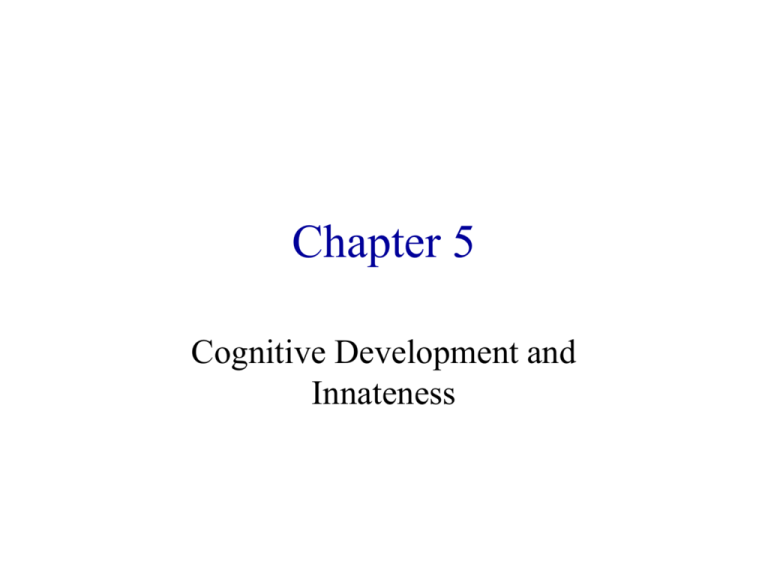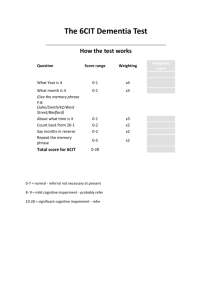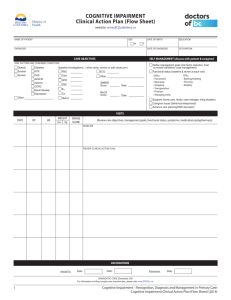PowerPoint slides
advertisement

Chapter 5 Cognitive Development and Innateness Nature/Nurture Debate • • • • British Empiricists vs. Nativists Ethologists and Behaviorists Developmental progression Stage theories – Sudden or gradual transfer? • Epigenetic landscape – Extreme environmental disruption needed to drastically alter general behavioural development Evolution of the Human Brain • Domain general – Pattern recognizer – Flexible • Domain specific – Innate modules – Task dependent Pattern Recognizer • Reverse Speech – – – – David John Oates What you really mean is spoken backwards "More energy and money and effort.” "You're frightened, lean on me.” Remez, Rubin, Pisoni & Carrell (1981) • Speech perception without traditional speech cues – – – – Three tone sinusoid replica Nothing but sine waves Priming Here’s the sine waves again Pareidolia • Phenomenon of perceiving familiar patterns in random or non-relevant structures • Our neurobiology lets us recognize people, process language, identify predators, etc. • Very strong evolutionary selective forces for these abilities • Pareidolia is a byproduct, or spandrel, of selection for our other, useful, neurological pattern recognizing capacity Some Other Examples • The Doors, Break on Through – "Treasures there”, becomes "I am Satan” – But, if you don’t cut the backwards tape off at the right place you really get, "I am Satanschmegel” • Electronic voice phenomena – Alleged ghost voices O Fortuna • Misheard lyrics Fodor (1983) • “Modularity of mind” – Different brain systems work only with certain kinds of data – Other data available, but not utilized – Module impenetrability Fodor’s Modularized Brain • A collection of independent perceptual modules – Each has a specific task – Work independently – Process sensory information rapidly • Central cognitive processes – Non-modularized – Slow Geometric Module • Ken Cheng • Ignore salient landmarks • Use overall spatial geometry of environment Transformations Training 18 0 1 6 Testing 180° Rotation 6 0 90° Rotation 1 18 0 18 6 1 Geometry long short short Short to left, Long to right Short to left, Long to right Short to right, Long to left Short to right, Long to left long 180° Rotation S to l, L to r S to l, L to r S to r, L to l S to r, L to l 90° Rotation S to r, L to l S to r, L to l S to l, L to r S to l, L to r Massive Modularity • Cosmides & Tooby (1992) – “Swiss army knife” model – An extreme view • Heavy-duty Nativist perspective; innate – Modules for everything, including cognitive processing • Not limited to perceptual modules Criticisms • No flexibility – Only capable of dealing with previously evolved problems • Recent developments? • Interaction? – What regulates the separate modules? Actual and Proper Domains • Actual domain of a module – Anything that satisfies its basic requirements • Proper domain of a module – The stimulus/stimuli that, by activating the module, gives adaptive value Bug Detector • Frogs have cells in visual system that fire when small objects move in particular ways • Causes frog to fire its tongue out • Cells also fire when small stones tossed in front of a frog • Flies are proper domain, stones are actual domain • Toss bits of chopped up meat passed pet frog • Bits of meat are not just actual domain, but also part of proper domain Development • Does modularity preclude developmental change? • Karmiloff-Smith – – – – Predispositions (domain-relevant biases) Domains: biology, physics, psychology Focus attention; not modules With experience, adults develop “modular-like” structures – Representational redescription • Beyond information encapsulation; cross domain • From implicit to abstract representations Face Recognition • A module? • Infants – Respond to faces early – Graded neurological/brain region response • Categorization – Gauthier et al. (1999) – Birds and cars – Same region as face recognition Social Cognition • Language, culture, politics, etc. • Cognition interacting with decision making • Humans – Highest level of functioning Theory of Mind • Descarte – “I think, therefore I am.” • ToM – “I think that you think, and that your thoughts drive your behaviour.” – The content of another’s mental state may differ from our own, and/or from the reality of the situation. Intentionality • States of mind about beliefs and desires • Reflexive hierarchy • First order: belief-desire – I believe. • Second order: ToM – I believe that you suppose. • Third order – I believe that you suppose that I want this. How Far can this Go? • Kinderman et al. (1998) – Higher order intentionality – Vignettes – Questions about: • Mental states of people in vignette • Facts from vignette – Fine up to four orders of intentionality • “I believe that you think that I intend to deceive you.” • Stressing cognitive abilities • Neocortex size • Women perform better than men ToM Developmental Benchmarks • <18 months – Joint attention • Intentionality and eyedirection detectors – Self and social referencing • 18-24 months – Pretend play – Primary representations – Desire psychology • Understanding of internal drives • 36 months – Secondary representation • Beliefs about beliefs – Deceit • 48-56 months – False belief task • Smarties or Sally-Anne methodology • Meta-representational thought Machiavellian Intelligence • Social living • Deception and manipulation • Understanding of your own and others’ intentions • Excel and prosper Comparisons for Understanding • Normal to abnormal • Gross morphological brain damage • “Subtle” neurophysiological deficits Autism • • • • 0.05% of children No obvious neurological damage Language, cognitive, social impairment ToM False Belief Test 100 Passing (%) • 4 year old • Normal and Down’s syndrome • Autistic • Not intelligence or cognitive 50 normal Down’s Subjects autistic • Autistics also fair poorly on true belief task – High-functioning autistics • General rules of thumb • Lack of deep social understanding • Impairment specific to belief states – Do well on false photo (memory) tasks • No joint attention, poor lies, no/limited pretend play, don’t understand desire ToM Module Debate • ToM module deficit – Primary problems • Affective disorders – Secondary problems • Indifference to people, literalists • Dual deficit – ToM – Weak central coherence • Problem organize parts into groups – Illusions, face-recognition, embedded figure • Advantageous in some situations Genetic Component • Fathers of autistics – Better at piecemeal local processing tasks • Physics, engineering, and autism • 4:1 male:female cases of autism • Extreme form of “male brain” – Continuum – Folk physics vs. folk psychology Williams Syndrome • Chromosome 7 gene deficits • Low IQ • Very good language skills and musical ability – Williams and language (4:46-6:29) • Very sociable – Intense interest in people, excellent face-processing skills – Poor social judgment; trouble with friendships • Same impairment on false belief as autistics ToM • Two separate components – Social-cognitive component • Represents mental states of others – Social-perceptual component • Represents the emotional states of others • Tager-Flusberg & Sullivan (2000) – Autistics have impairment in both components – Williams syndrome have less impairment on social-perceptual component Conclusions • Fodarian perceptual modules generally accepted • Most evolutionary psychologists strongly favour existence of at least some higher cognitive modules • Debate as to the impenetrability of cognitive modules • Strong evidence for general-domain system, too





